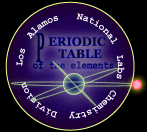

| Atomic Number: | 33 | Atomic Radius: | 125 pm | ||
| Atomic Symbol: | As | Melting Point: | ~817 �C | ||
| Atomic Weight: | 74.9216 | Boiling Point: | 603 �C (sublimation) | ||
| Electron Configuration: | [Ar]4s23d104p3 | Oxidation States: | 5, 3, -3 |
(L. arsenicum, Gr. arsenikon: yellow orpiment, identified with arenikos: male, from the belief that metals were different sexes; Arabic, Az-zernikh, the orpiment from Persian zerni-zar, gold) Elemental arsenic occurs in two solid modifications: yellow, and gray or metallic, with specific gravities of 1.97, and 5.73, respectively. It is believed that Albertus Magnus obtained the element in 1250 A.D. In 1649 Schroeder published two methods of preparing the element. Mispickel arsenopyrite, (FeSAs), is the most common mineral from which, on heating, the arsenic sublimes leaving ferrous sulfide.
The element is a steel gray, very brittle, crystalline, semimetallic solid; it tarnishes in air, and when it is heated it rapidly oxidizes to arsenous oxide, which smells of garlic. Arsenic and its compounds are poisonous.
Arsenic is used in bronzing, pyrotechny, and for hardening and improving the sphericity of shot. The most important compounds are white arsenic, the sulfide, Paris green, calcium arsenate, and lead arsenate; the last three have been used as agricultural insecticides and poisons. Marsh's test makes use of the formation and ready decomposition of arsine. Arsenic is finding increasing uses as a doping agent in solid-state devices such as transistors. Gallium arsenide is used as a laser material to convert electricity directly into coherent light.
Title Picture: Alchemical symbol for arsenic

Sources: CRC Handbook of Chemistry and Physics and the American Chemical Society.
Last Updated: 10/20/2003,� Chemistry Operations
Operated by the University
of California for the US Department
of Energy
|
Help
| Copyright � UC 2003 | Disclaimer